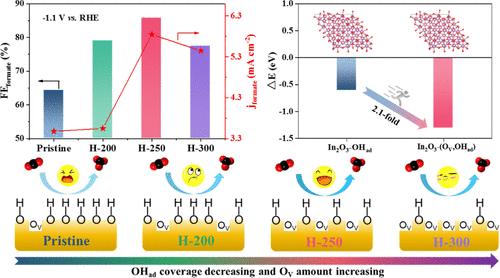通过同时调整In2O3的羟基覆盖和氧空位量,有效地电还原CO2为甲酸盐
IF 7.3
1区 化学
Q1 CHEMISTRY, MULTIDISCIPLINARY
引用次数: 0
摘要
用电化学方法将二氧化碳还原(ECR)为高附加值原料是解决能源和环境问题的一种可持续方法。然而,在理解 ECR 催化剂的结构-活性关系方面仍然存在瓶颈。在本文中,我们证明了同时调节 In2O3 表面吸附的羟基(OHad)覆盖率和氧空位(OV)数量是一种有效的方法,可在 -1.0 至 -1.5 V 的宽电位范围内,相对于可逆氢电极(vs RHE)获得超过 80% 的优异甲酸法拉第效率(FE),并且具有良好的耐久性。电化学实验和理论分析表明,OHad 和 OV 的协同效应可以优化吸附位点,加速电子转移,稳定 *CO2-- 和 *OCHO 中间产物,从而促进 ECR 活性。这一结果将有助于理解这些表面氧物种在 ECR 中的关键作用,从而为合理设计催化剂以实现二氧化碳的高效综合利用提供有价值的见解。本文章由计算机程序翻译,如有差异,请以英文原文为准。

Efficient Electroreduction of CO2 to Formate via Simultaneous Tuning of Hydroxyl Group Coverage and Oxygen Vacancy Amount of In2O3
Electrochemical CO2 reduction (ECR) to high value-added feedstocks is a sustainable way to address energy and environmental issues. However, there still exists a bottleneck in comprehending the structure–activity relationship of catalysts for ECR. Herein, we demonstrated that the simultaneous tuning of surface-adsorbed hydroxyl group (OHad) coverage and oxygen vacancy (OV) amount on the In2O3 surface was an effective approach to derive an excellent formate Faradaic efficiency (FE) of above 80% at a wide potential range from −1.0 to −1.5 V versus the reversible hydrogen electrode (vs RHE) with promising durability. Electrochemical experiments and theoretical analyses revealed that the synergistic effect of OHad and OV could smartly optimize the adsorption sites, accelerate the electron transfer, and stabilize *CO2•– and *OCHO intermediates, and thus facilitate ECR activity. This result will contribute to the understanding of the critical role of these surface oxygen species in ECR, which can offer valuable insights into the rational catalyst design for comprehensive utilization of CO2 with high energy efficiency.
求助全文
通过发布文献求助,成功后即可免费获取论文全文。
去求助
来源期刊

ACS Sustainable Chemistry & Engineering
CHEMISTRY, MULTIDISCIPLINARY-ENGINEERING, CHEMICAL
CiteScore
13.80
自引率
4.80%
发文量
1470
审稿时长
1.7 months
期刊介绍:
ACS Sustainable Chemistry & Engineering is a prestigious weekly peer-reviewed scientific journal published by the American Chemical Society. Dedicated to advancing the principles of green chemistry and green engineering, it covers a wide array of research topics including green chemistry, green engineering, biomass, alternative energy, and life cycle assessment.
The journal welcomes submissions in various formats, including Letters, Articles, Features, and Perspectives (Reviews), that address the challenges of sustainability in the chemical enterprise and contribute to the advancement of sustainable practices. Join us in shaping the future of sustainable chemistry and engineering.
 求助内容:
求助内容: 应助结果提醒方式:
应助结果提醒方式:


